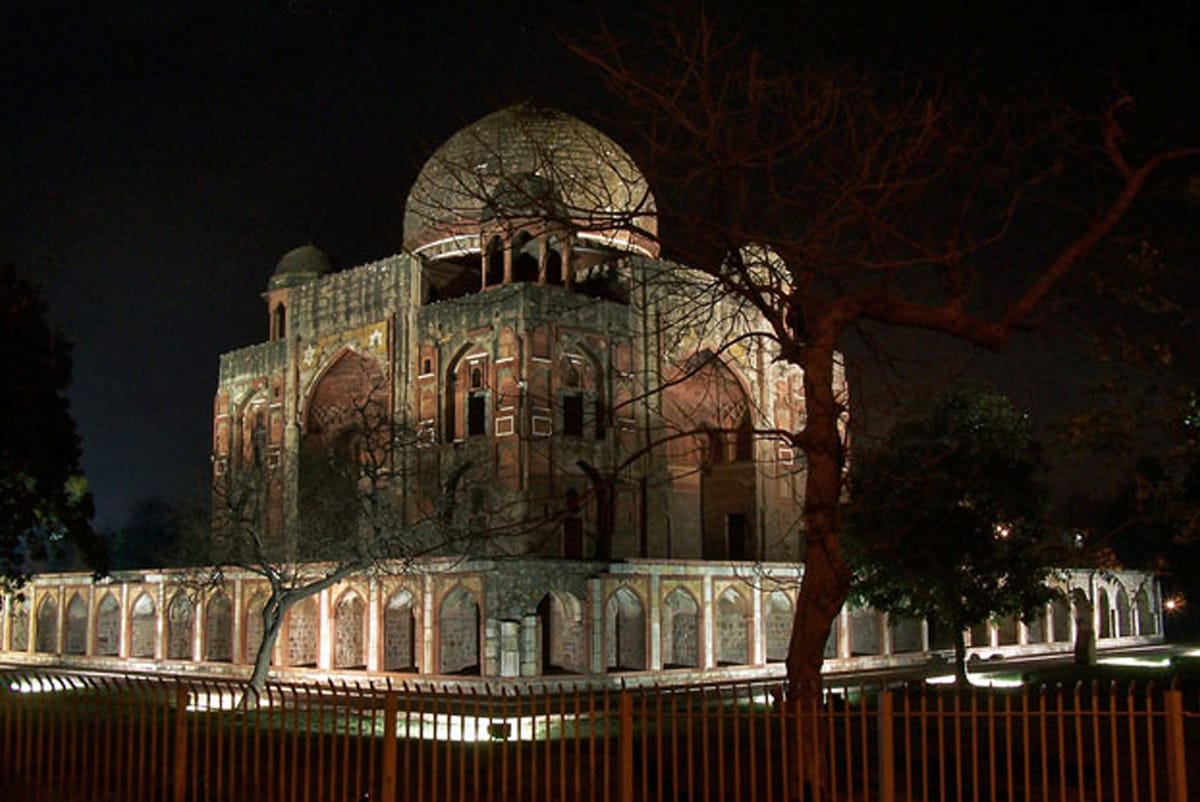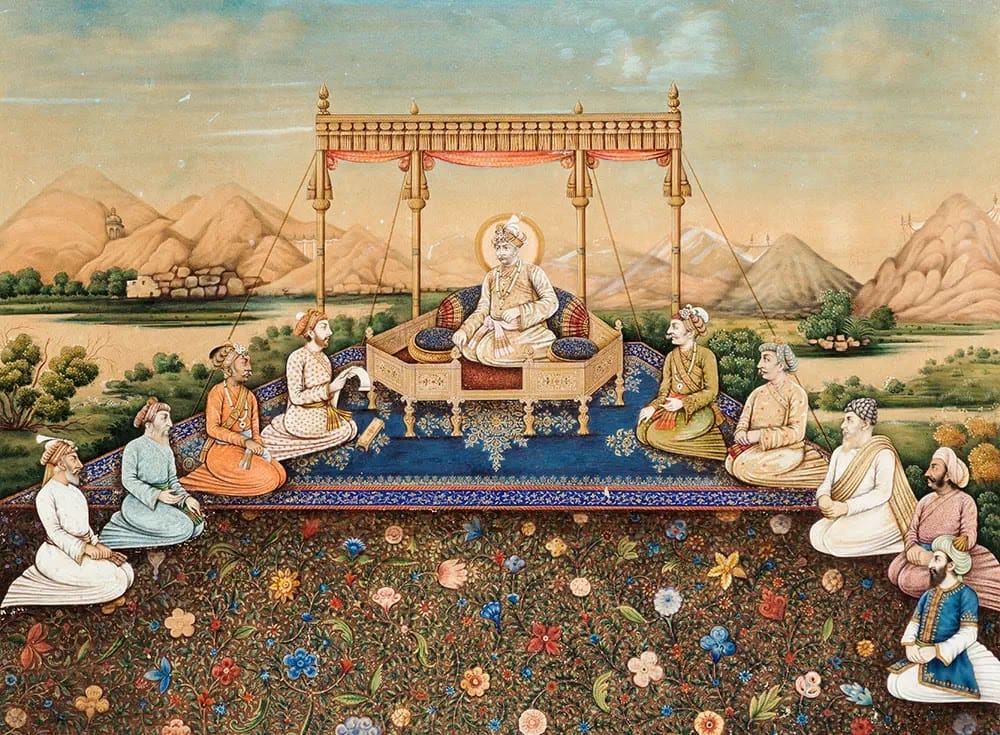Khan-i-Khanan Tomb

Everyone knows about Shah Jahan's love for his wife Mumtaz Mahal and how that love was immortalised by him with the construction of, arguably the most famous and magnificent mausoleum, Taj Mahal. However, very few people know that one of Akbar's Navratan, Abdul Rahim Khan-i-Khanan, did the grand gesture for his deceased wife much before Shah Jahan did. Let's get more familiar with the Khan-i-Khanan Tomb
About Abdul Rahim Khan-i-Khanan
Abdul Rahim Khan-i-Khanan, colloquially known as Rahim, was a prominent figure in the court of the Mughal Emperor Akbar during the 16th century. He was valued not only for his political and administrative abilities but his contributions to literature, particularly in poetry, far outweigh everything else he did. Rahim's literary works, written in Persian and Braj Bhasha, continue to be celebrated for their wisdom, wit, and timeless appeal.

Abdul Rahim Khan-i-Khanan was born in 1556 in Delhi. He was the son of Bairam Khan, a trusted advisor and mentor to Emperor Akbar. Bairam Khan was a prominent figure in Humayun's administration and heavily involved in his campaigns against Bengal and Gujarat. Rahim received a comprehensive education in Persian literature, Islamic theology, and statecraft, which prepared him to take his father's place in the future. His upbringing in the courtly circles of the Mughal elite exposed him to the arts, culture, and intellectual currents of the time, shaping his political worldview and aesthetic sensibilities.
Rahim and the rest of his family were taken to Ahmedabad after the death of his father in Gujarat and Akbar integrated him into his court, thus kickstarting his rise to prominence in the Mughal court. His seamless transition was facilitated by his family connections and his own talents as a statesman and administrator. He served in various administrative positions throughout his career, holding titles such as Khan-i-Khanan (Commander of Commanders) and Mir Bakhshi (Master of the Royal Stables).
Rahim's contributions to the Mughal administration were significant, particularly in the realm of revenue management and military affairs. He played a key role in implementing Akbar's land revenue system, known as the zabt system, which aimed to rationalize taxation and promote agricultural productivity.
In addition to his administrative duties, Rahim also distinguished himself as a military commander, leading campaigns against rebellious factions and external threats to the empire. He was appointed the chief of Ajmer and led the Mughals against Maharana Pratap. His strategic acumen and leadership skills earned him the respect and admiration of his contemporaries, including Emperor Akbar himself.
However, while Rahim's contributions to the Mughal administration were noteworthy, he is perhaps best remembered for his literary achievements. Rahim was a prolific poet who composed verses in Persian and Braj Bhasha, a literary language derivative of Sanskrit and commonly spoken throughout the North India.
His poetry is defined by its simplicity, elegance, and profound wisdom, which reflects his deep understanding of human nature and the human condition. His verses often explore themes such as love, morality, spirituality, the value of secularism and the fleeting nature of life, offering timeless insights that resonate with readers across generations.
One of Rahim's most famous literary works is the "Rahim Ke Dohe," a collection of couplets (dohas) that distill complex philosophical and ethical concepts into simple, memorable verses. These dohas are widely recited and admired for their universal wisdom and moral guidance, making Rahim a beloved figure in Indian literature and culture. So significant was his work that even Tulsidas wrote a couplet for him, and Rahim replied in kind, by writing one of his own for him.
Who were the Navratnas?

Akbar was known for his patronage of the arts, sciences, and literature. He was also known to be a wise ruler and thus surrounded himself with a diverse group of intellectuals, scholars, and advisors, collectively known as the "Navaratnas" or "Nine Jewels." These individuals, each with mastery in their respective fields, contributed significantly to Akbar's court and played pivotal roles in shaping the cultural and intellectual landscape of the Mughal Empire. These were Abul Fazl, Birbal, Tansen, Faizi Todar Mal, Raja Man Singh, Mullah Do Pyaza, Fakir Aziao-Din and finally, Abdul Rahim Khan-i-Khanan
About the Tomb
The Khan-i-Khanan Tomb was commissioned by Abdul Rahim to honor the memory of his wife, Mah Banu. The char bagh (Mughal-style gardens) of the tomb used to extend all the way to Humayun's tomb at one point, which was an inspiration for it. The tomb was built in 1598 in Nizamuddin East, which is also close to the Nizamuddin Dargah. 29 years after its construction, Abdul Rahim's body was placed in the tomb as well. The tomb itself was made of sandstone on the outside and marble on the inside, which is littered with intricate carvings.
However, it fell into ruins in the 18th century, as it was plucked for raw materials by the son of Safdurjung to build a tomb in service of his father close by. As the tomb lay in disarray, the InterGlobe Foundation and the Aga Khan Trust for Culture announced a project to oversee its resurrection and maintenance in 2014. The tomb opened its gate for visitors in the December of 2020, after over 3000 workers had put in great efforts to give it a new lease of life. This was one of the biggest conservation projects ever undertaken and for good reason- the Khan-i-Khanan tomb was the first tomb ever built in India as a symbol of love for one's partner. This tradition was later perfected by Shah Jahan in the form of the Taj Mahal.
Food Near Khan-i-Khanan Tomb
Ghalib Kebab Corner
Ghalib Kebab Corner in Nizamuddin is renowned for its delectable kebabs, especially their seekh kebabs. It's a small, unassuming joint that has garnered a loyal following over the years due to its flavorful and succulent kebabs. The aroma of sizzling meat being barbecued over the grill is sure to tempt anyone passing by. The place is named after the famous Urdu poet Mirza Ghalib, adding a cultural touch to its culinary offerings. If you're ever in Delhi and craving some authentic kebabs, Ghalib Kebab Corner is definitely worth a visit for their Mutton Malai Kebabs alone!
Manpasand Nahari Roti Wale
Manpasand Nahari Roti Wale is a place that specializes in serving nahari traditional Indian curry made with slow-cooked meat along with khamiri roti or kulcha. They serve other Mughlai delicacies too and they excel thoroughly at them, but their nihari is truly a class apart.
Mehboob-e-Ilahi and Nasir
Both these establishments are not huge in size, but what they lack in appearance they make up for with their delectable sweets. Mehboob-e-Ilahi mostly sells samosas and imartis, but it's the latter that they are really known for- juicy and full of flavour. If you're not a fan of Imartis, then you can try the kheer served in earthen pots just down the road at Nasir Iqbal Restaurant, who top it off with a chandi varq to give you a sense of royalty.
Nearby Attractions
Sundar Nursery
Sundar Nursery is a historic garden complex transformed into a haven. Originally established during the Mughal era, it underwent extensive restoration, blending historical preservation with modern landscaping techniques. The nursery boasts diverse flora, including rare indigenous species, spread across its picturesque landscape. Its pathways meander through lush greenery, dotted with ancient monuments, pavilions, and water features, creating a serene ambiance for visitors. Sundar Nursery serves as not only a botanical oasis but also a cultural and recreational destination, inviting exploration and contemplation amidst its natural and historical splendor.
Humayun's Tomb
Humayun's Tomb was built to serve as the final resting place for Emperor Humayun, the second ruler of the Mughal Empire. Emperor Humayun ruled from 1530 to 1556 and was known for his patronage of the arts and architecture. The construction of Humayun's Tomb was commissioned by Humayun's widow, Empress Bega Begum, shortly after his death. Bega Begum was deeply devoted to her husband and was determined to honor his memory in a fitting manner. She spared no expense in building a mausoleum that would reflect Humayun's stature as an emperor and showcase the cultural sophistication of the Mughal Empire. Beyond serving as a burial place for Emperor Humayun, the tomb also had symbolic significance. It was meant to demonstrate the continuity and stability of the Mughal dynasty, despite the challenges it faced during Humayun's reign.
Isa Khan's Tomb
The tomb is dedicated to Isa Khan Niazi, a nobleman in the court of Sher Shah Suri, who ruled Delhi in the mid-16th century. The structure, built in 1547-48, predates Humayun's Tomb and exhibits a far simpler architectural style. It is constructed mainly of sandstone and features a square chamber topped with a dome, surrounded by a verandah with intricate jali (lattice) work. Adjacent to the tomb is the Isa Khan Mosque, also built during the same period. This mosque follows a traditional Indian architectural style with elements such as chhatris (pavilions) and jaalis. It serves as a place of worship and reflects the religious and cultural syncretism prevalent during the Mughal era.
Nizamuddin Dargah
The dargah, or shrine, is a place of pilgrimage and spiritual significance for millions of devotees, regardless of their religious affiliations. The architecture of the dargah comprises several structures, including the tomb of Hazrat Nizamuddin Aulia, adorned with intricate marble lattice work, calligraphy, and colorful embellishments. One of the defining features of the Nizamuddin Dargah is its vibrant atmosphere, characterized by the sounds of qawwali music, devotional poetry, and the fragrance of incense. Devotees gather at the dargah to offer prayers, seek blessings, and participate in spiritual gatherings known as mehfils
Safdurjung Tomb
ommissioned by Nawab Shuja-ud-Daula, the son of Safdarjung, after pleading with the Mughal ruler, to honor his father's memory. The construction of Safdarjung's Tomb commenced and was completed in 1754 by Bilal Muhammad Khan and took about 3 lakh rupees to complete. The tomb's location, on a prominent avenue in the heart of Delhi, reflects the significance of Safdarjung's role in the Mughal court and his contribution to the administration of the empire. The central focus of the complex is obviously the mausoleum itself, built primarily of red sandstone and marble. The tomb stands on a raised platform, giving it a commanding presence amidst the surrounding garden.
How to get to Khan-i-Khanan Tomb
The tomb of Abdul Rahim Khan-i-Khanan is located in the Nizamuddin East area of New Delhi, India. People looking to reach the tomb The nearest can get off at the JLN Stadium Metro Station or the Jangpura Metro Station, both which are on the Violet Line. Alternatively, you can also get off at the Hazrat Nizamuddin Metro Station, which falls on the pink line. Once at one of these metro stations, you can either walk to the tomb or take an auto/e-rickshaw, which can take you there either privately or on a sharing basis, whichever one you prefer. Taxis and auto-rickshaws are readily available throughout Delhi and can be hired for a direct trip to the Khan-i-Khanan Tomb. You can either use apps like Uber or Ola or hail a taxi or auto-rickshaw from the street. Private vehicles, due to congestion and lack of parking, are discouraged but they always remain an option.
Tickets and Timings
The Khan-i-Khanan Tomb opens its gates to visitors right around sunrise at 6 AM in the morning, and closes them after exactly 12 hours at 6 PM. The ticket prices for Indian citizens are a measly 20 INR, whereas foreign visitors are expected to pay roughly 250 INR. Due to the conservation efforts, food is strictly prohibited inside in order to prevent any littering.

Comments ()